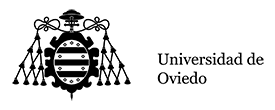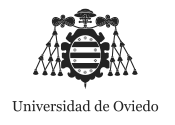Antropología Física
- Prácticas de Aula/Semina (7 Hours)
- Prácticas de Laboratorio (14 Hours)
- Clases Expositivas (35 Hours)
- Tutorías Grupales (2 Hours)
La Antropología Física estudia la variabilidad genética, bioquímica, fisiológica, morfológica y demográfica de la especie humana tanto en el tiempo como en el espacio. Se encuadra en el campo del conocimiento y del análisis de la biodiversidad del Hombre como especie, y en el campo de la Biología Evolutiva a través de la interpretación del registro fósil. El desarrollo de las técnicas de fenotipación de marcadores genético-moleculares en tejidos humanos actuales y subfósiles ha dado lugar a nuevas especializaciones que forman parte del bagaje de conocimientos esenciales para los graduados en Biología.
La asignatura de Antropología Física se encuentra en el Módulo II Biología Fundamental y la materia Antropología Física.
Competencias Transversales:
Capacidad de análisis y síntesis, capacidad de organización y planificación, capacidad de gestión de la información, comunicación oral y escrita, capacidad de desarrollar un trabajo en equipo y del razonamiento crítico.
Desarrollo del aprendizaje autónomo, adaptación a nuevas situaciones y motivación por la calidad.
Competencias Específicas:
Comprensión holística de los factores que han determinado el origen y variabilidad de las poblaciones humanas.
Conocer las características generales, tendencias evolutivas y sistemática del Orden Primates.
Conocer los restos fósiles vinculados a la historia evolutiva del Orden Primates.
Integrar las adaptaciones de los homínidos en el proceso evolutivo de la especie humana.
Conocer las diferentes manifestaciones de la biodiversidad molecular humana.
Conocer el estado actual de los estudios de la biodiversidad humana a partir de la síntesis de las aportaciones de la epidemiología, la fisiología, la demografía y la antropología biológica y cultural.
Conocer los métodos y técnicas en el estudio del grupo zoológico humano. Presentar la variabilidad actual como expresión de distintas formas de adaptación medio-ambiental.
Conocer el origen de los homínidos y principales fases de la antropogénesis.
BLOCK 1. INTRODUCTION TO PHYSICAL ANTHROPOLOGY. Concept and objectives in Physical Anthropology. The fields of study in Physical AnthropologyBLOCK 2. BASIC PRINCIPLES OF EVOLUTIONARY BIOLOGY AND ITS APPLICATION TO THE HUMAN POPULATION. Conceptual bases of the process of human evolution. Morphological evolution and molecular evolution. The fundamentals of genetic variation in human populations. Biogeography and Genetics. The evolutionary processes (1). Mutation and natural selection in humans. Evolutionary processes (2) Migration and genetic drift. The evolutionary processes (3. Taxonomic position of the human specie. Biological evolution and cultural evolution: culture as an adaptation.BLOCK 3. THE EVOLUTIONARY HISTORY OF THE HUMAN LINEAGE. Paleoecology and dating. The current Primates. Characteristics and adaptations. Evolutionary trends. Phylogeny: morphology and molecular data. Origin and evolution in primates. First representatives of the Homininin Tribe. Origin and evolution of the genus Homo. Homo erectus / ergaster. The expansion of the genus Homo. Homo neanderthalensis.Theories about the origin and expansion of Homo sapiens.BLOCK 4. GENETIC POLYMORPHISMS AND HUMAN BIOLOGICAL DIVERSITY. Classical genetic polymorphisms. Leukocyte markers and human immunoglobulins. Genetic molecular polymorphisms of DNA and the study of human populations. Interpretive bases of the polymorphic variation of DNA in human groups. Genetic polymorphisms and the study of human populations.BLOCK 5. HUMAN BIOLOGY AND CULTURAL CHANGE. The Genetic Epidemiology. Diseases from the evolutionary point of view. Human adaptation to climate. The human adaptation and nutrition.BLOCK 6. THE POPULATIONS OF THE LARGE CONTINENTAL AREAS AND THEIR POPULATION. The meaning of human variation. The populations from Africa Europe and the European population. The populations from Asia and India. The populations from Australia and the South Pacific. The populations from America.PRACTICES1. Morphological anthropology (Somatology). Estimation of body composition and somatotype2. Osteology and Forensic Dentistry.3. Neurocranium and splanchnocranium4. Cranial capacity, prognathism and anthropometry of the jaw5. Determination of sex and age in skeletal remains6. The postcranial skeleton. The stature in the skeletal remains7. Dactyloscopy
TRABAJO PRESENCIAL | TRABAJO NO PRESENCIAL | |||||||||||
Temas | Horas totales | Clase Expositiva | Prácticas de aula /Seminarios/ Talleres | Prácticas de laboratorio /campo /aula de informática/ aula de idiomas | Prácticas clínicas hospitalarias | Tutorías grupales | Prácticas Externas | Sesiones de Evaluación | Total | Trabajo grupo | Trabajo autónomo | Total |
BLOQUE 1 | 2 | 1 | 0 | 3 | 1 | 2 | 3 | |||||
BLOQUE 2 | 4 | 1 | 2 | 7 | 5 | 8 | 13 | |||||
BLOQUE 3 | 12 | 2 | 2 | 1 | 15 | 11 | 13 | 24 | ||||
BLOQUE 4 | 7 | 1 | 4 | 12 | 10 | 13 | 23 | |||||
BLOQUE 5 | 6 | 1 | 4 | 11 | 10 | 11 | 21 | |||||
BLOQUE 6 | 2 | 1 | 2 | 1 | 8 | 3 | 5 | 8 | ||||
Total | 150 | 33 | 7 | 14 | 2 | 2 | 58 | 40 | 52 | 92 | ||
MODALIDADES | Horas | % | Totales | |
Presencial | Clases Expositivas | 33 | 22.00 | 38.66% |
Práctica de aula / Seminarios / Talleres | 7 | 4.60 | ||
Prácticas de laboratorio / campo / aula de informática / aula de idiomas | 14 | 9.30 | ||
Prácticas clínicas hospitalarias | - | - | ||
Tutorías grupales | 2 | 1.33 | ||
Prácticas Externas | - | - | ||
Sesiones de evaluación | 2 | 1.33 | ||
No presencial | Trabajo en Grupo | 40 | 26.67 | 61.34% |
Trabajo Individual | 52 | 34.67 | ||
Total | 150 | |||
ACTIVIDADES A REALIZAR EN LAS CLASES DE TEORÍA Y PRÁCTICAS DE AULA:
Seguir la explicación teórica, tomando notas, repasando los artículos científicos, esquemas e ilustraciones que se facilitaran en los diferentes temas, previamente a la clase, para su lectura.
Discutir por grupos las dudas que vayan surgiendo.
Debatir, al final de los temas que se presten a ello, las cuestiones que se hayan ido proponiendo a lo largo de la explicación y resolver las dudas que se planteen.
Fuera de clase el alumno llevará a cabo su trabajo individual:
- Leer la bibliografía propuesta para cada tema, hacer esquemas, resolver las cuestiones que el profesor plantee en clase.
- De manera individual o en grupo se buscará información complementaria en diversas fuentes bibliográficas, por medios telemáticos, etc…
ACTIVIDADES A REALIZAR EN LAS CLASES DE PRÁCTICAS:
Están previstas7 prácticas que se impartirán en 14 horas y cuya finalidad es completar aspectos teóricos del programa que incluyan el conocimiento somatológico del individuo, la anatomía ósea y las principales determinaciones a las que se pueden llegar mediante el estudio de los restos óseos (edad, sexo, características individualizantes, patologías), así como abarcar aspectos de la identificación forense a través de el estudio de la huella dactilar.
El alumno seguirá una breve explicación que el profesor dará al inicio del tema, donde expondrá igualmente el trabajo a desarrollar en la sesión práctica. Se facilitará al alumno un guión para que tome sus anotaciones y sea más fácil el desarrollo de estas sesiones prácticas.
Means of AssessmentTHEORY:The preparation and presentation of homeworks a maximum of 20% of the final markThe written exam will have a value of 60% .It will be a single exam at the end of the course.PRACTICES: 20% of the final mark. The evaluation of the laboratory practices was carried out in a single final exam and will consist of several parts: identification of hominid templates and short questions on visual aspects during the development of the practices and knowledge and evaluation were evaluated. skills acquired by the student. The exam must be passed with a minimum of 5 points.GLOBAL RATING:To pass the subject it is necessary to pass the practical and the theoretical exam.Extraordinary exams:• A unique theory test, which will represent 60% of the total score.• An examan of laboratory practices was carried out, which will represent 20% of the total grade.• The marks that have been obtained in the Laboratory Practices and Evaluation of complementary activities will be maintained throughout the academic year (20%).In the case of the students who received the differentiated evaluation, the same evaluation that is established for the extraordinary exams will be applied.
- AGUSTI, J. (2000): Antes de Lucy. El agujero negro de la evolución humana. Libros para pensar la Ciencia. Ed. Tusquets. Fundación La Caixa. Barcelona. 286 pp.
- ARSUAGA, J. L. (2001): El enigmade la esfinge. Ed. Plaza Janés, S. A. Barcelona. 415 pp.
- ARSUAGA, J.L. (1999): El collar del neandertal. En busca de los primeros pensadores. Ed. Temas de hoy. Madrid.
- ARSUAGA, J.L. y MARTÍNEZ, I. (1998): La especie elegida. Ed. Temas de hoy. Madrid.
- BERMUDEZ DE CASTRO,J.M. (2002):El chico de la Gran Dolina. Ed. Barcelona..
- BOYD, R. Y SILK J.B.(2001): Cómo evolucionaron los humanos. Ed. Ariel. Barcelona.
- CARBONELL, E.(2003): Los sueños de la evolución. National Geographic. Barcelona.
- CARBONELL, E. (Coor.) (2005): Homínidos: Las primeras ocupaciones de los continentes. Ed. Ariel. Barcelona.
- CORBELLA, J., CARBONELL, E., MOYA, S., SALA, R. (2000): El largo camino de los homínidos hacia la inteligencia. Ed. Península. Barcelona
- JONES, S. MARTIN, R. y PILBEAM, D. (1992): The Cambridge Encyclopedia of Human Evolution. Cambridge University Press.
- JOHANSON, D. y BLAKE, E.(1996): From Lucy to language. Simon and Shuster, Eds. Nueva York.
- LEWIN, R. (1993): Evolución Humana. Biblioteca Científica Salvat.
- PALEONTOLOGIA HUMANA (1988): Libros de Investigación y Ciencia. Ed. Prensa Científica.
- PRIMATES. NUESTROS ANTEPASADOS (1991): Ediciones Folio. Colección Animales del Mundo.
- STRICKBERGERG M.W. (1993): Evolución. Ed. Omega. Barcelona. Capítulos 18 y 19.
- STRINGER, C. y GAMBLE, C. (1996):En busca de los Neandertales. Ed. Crítica.
- TATTERSALL, I. (1999): Hacia el ser humano. La singularidad del hombre y la evolución. Ed. Península.

